
The Yellowstone Park was dedicated on March 1, 1872, by an act of Congress as a National Park “For the Benefit and Enjoyment of the People”. Within a stretch of 2000 sq. miles, a traveler at Yellowstone may experience natural wonders from Geysers at Upper Basin, to Grand Canyons of Yellowstone with imposing waterfalls, to the largest lake, the Yellowstone Lake at an elevation of 7741 feet, to Great Terraces at Mammoth Hot Springs, and experience an incredible diversity of wildlife. The natural wonders and captivating wildlife at Yellowstone National Park is a photography dreamland for both professionals and amateur photographers. No matter where you are in the park, you will find great opportunities for capturing unique landscapes and wildlife. Here we list the best seven photo spots at the Yellowstone National Park. All the photographs below were taken using Nikon D810 with three lenses 50 mm Nikkor Prime, 11-16 mm Tokina 2.8, and Nikkor 200-500 mm.
NORRIS GEYSER BASIN

Nikon D810, ISO100, F11, 50mm, 1/8sec, Tripod
Norris Geyser Basin: At Norris Geyser Basin, you can really sense the immense power of the Yellowstone Caldera. The smokey atmosphere adds an almost otherworldly scenery. The Earth beneath you hums with hissing sounds of roaring mountain, steam intermittently blowing out of the vents, and geysers spit out water with immense power. In some parts, the geysers have porcelainized nearby trees, and the lifeless barren trees provides a sensory experience of solitude in sound, color, and smell. Norris Geyser Basin has two trail loops: the Back Basin and the Porcelain Basin. The Back Basin can be accessed via a 1.5-mile loop that goes through a wooded area passing many pools, springs, and geysers. Porcelain basin loop is a 0.75-mile trail that can be accessed by a boardwalk, cascades around a beautiful turquoise blue pools, and an area of emerald green and yellow runoff that contrasts well with blue or orange sky.
Photo tips: Arrive at Norris Geyser Basin 2-3 hours before sunset. Experience the hissing sounds of the mountains, hot water spitting from the geysers, and steam blowing out of the vents. Take the Back basin loop, and experience the alpine desert like landscape that looks otherworldly due to the diffused golden light, and stunning tones that are worthy of a picture. When the sun goes down (20 min before sunset), come to the Porcelain basin loop, and take your sturdy tripod and place it on the boardwalk. Start composing the nearby Green/Yellow runoff and emerald pools with wide angle lens (16 mm) towards the west facing the sun. Wait for the intense red/orange color of the sky that lights up in the distance. Take a shot when the colors are right. The fascinating vivid colors of reflection of sunset on the stream pools looks like a molten lava that may have flown at the early years of the creation of Yellowstone Caldera. On the east side, light is equally wonderful with pink color tones lighting the landscape. Enjoy the moment of tranquility.

ISO160 F8, 1/160sec, Hand held shot

ISO100, F11, 16mm, 1/13sec, Tripod

ISO100, F11, 16mm, 1sec, Tripod
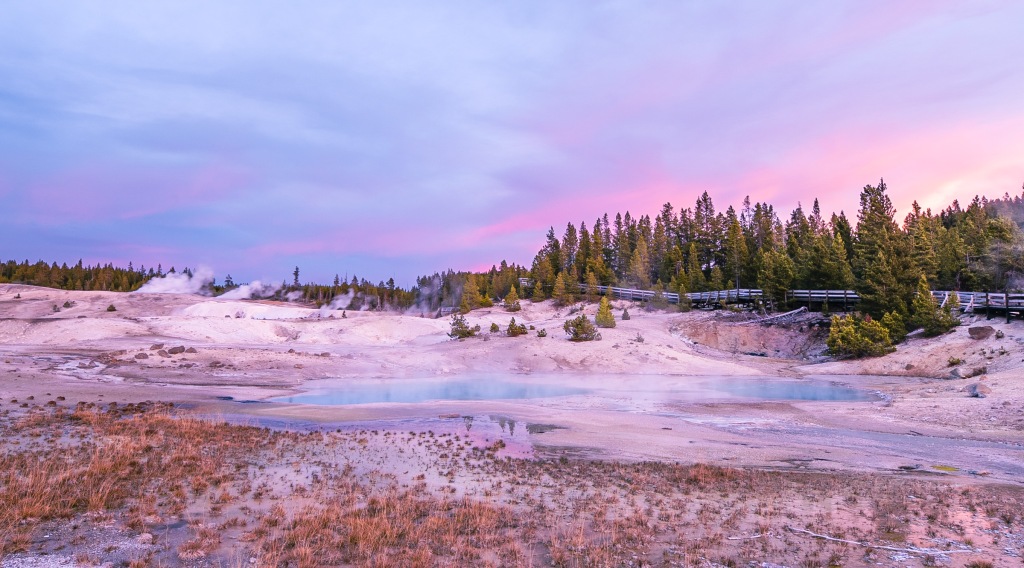
ISO100, F11, 16mm, 0.5 sec, Tripod

ISO200, F11, 16mm, 5sec, Tripod
MAMMOTH SPRINGS

ISO 100, 50mm, F9, 1/500sec, Hand held
Photo tips: The most popular spots to photograph in Mammoth Hot Springs is the Canary Spring Terraces. The hot springs create multi-colored layers of algae and cyanobacteria on the unique white background from the calcium carbonate deposit. The steps-like landscapes with colorful bacterial mats creates a perfect photo opportunity. I recommend bringing along with you a prime lens 50 mm and a telephoto lens (70-200 mm) to capture the alpine desert landscape along with detailed shots of Travertine formations. I personally used a wide life lens (200-500 mm) to capture shots at 250 mm, creating unique perspectives of calcite formations and their live habitats.
At Albright visitor center in Mammoth Springs, you encounter Elk herds, lush green grass, employee houses, hotels, cabins, and general stores. This place looks like a small town in itself, different from other locations of Yellowstone. One of the best photo opportunity is to capture the Elk bugle and charging Elks at the visitor center. There is a native herds of Elk that graze here, which can be photographed with a telephoto wild life lens (200-500mm).

ISO100, 200mm, F9, 1/500 sec, Hand Held

ISO100, 250mm, F9.0 1/250sec, Hand Held

ISO100, F9, 250mm, 1/250s, Hand held
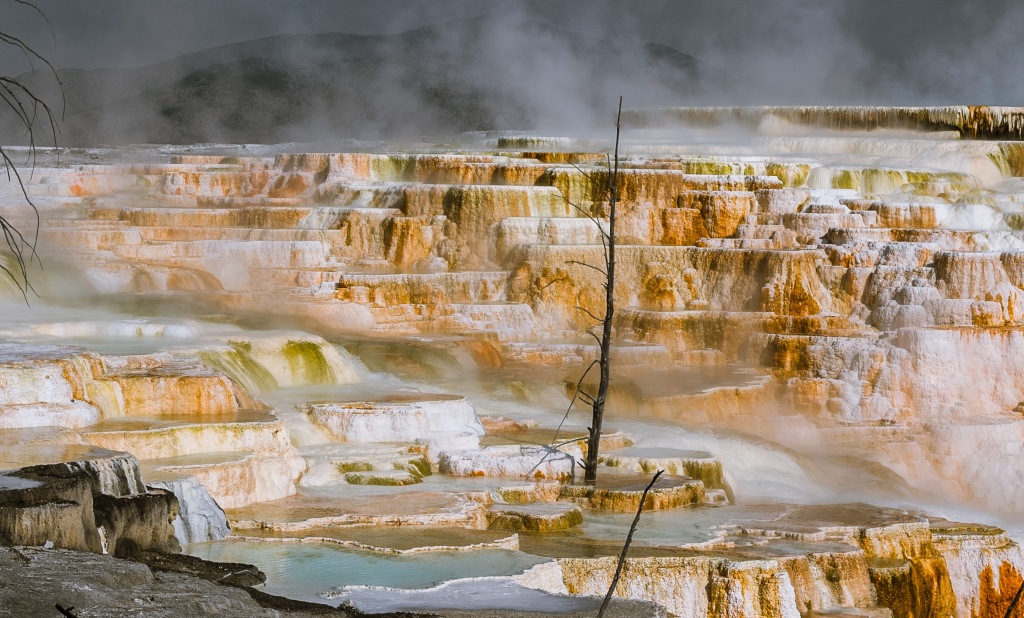
ISO 100, 50mm, F9, 1/250sec, Hand Held

ISO1600, 200mm, F6.3, 1/80sec. Hand Held placed on a car window for support.

ISO 2000, 370mm, F5.6 1/60sec, Hand Held placed on the window of the car for support
THE GRAND CANYON OF THE YELLOWSTONE
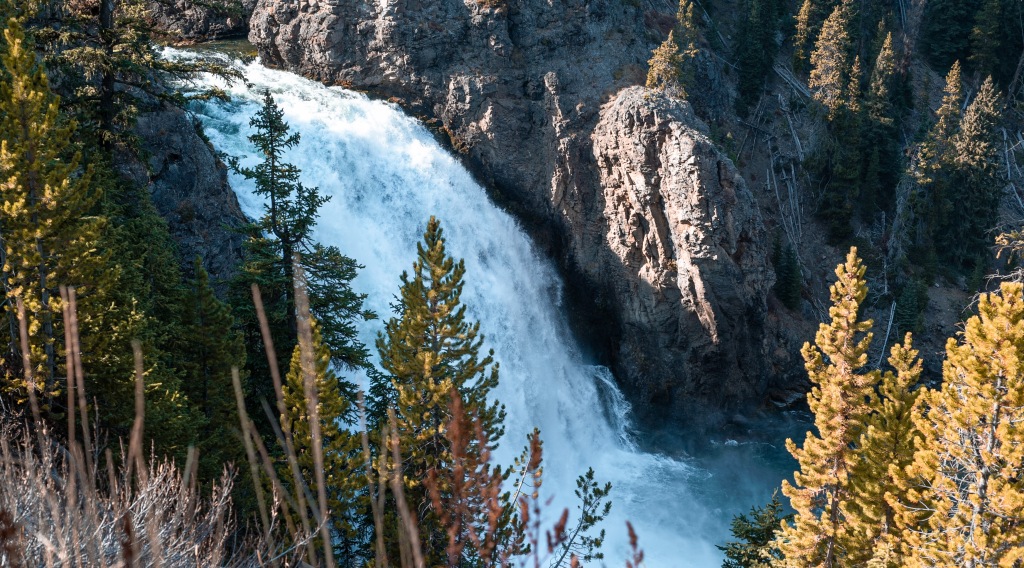
ISO200, 50mm, F7.1, 1/400sec
A pen picture by Dr. Wayland Hoyt describing the colors at the Canyon in Haynes guide published a century ago. “And then, of course, and almost beyond all else, you are fascinated by the magnificence and utter opulence of color. Those are not simple gray and hoary depths, and reaches and domes and pinnacles of hoary depths, and reaches and domes and pinnacles of sullen rock. The whole gorge flames. It is as though rainbows had fallen out of the sky and hung themselves there like a glorious banner. The underlying color is the clearest yellow; this flushes onward to orange. Down at the base the deepest mosses unroll their draperies of the most vivid green; browns, sweet and soft, do their blending; white rocks stand spectral; turrets of rock shoot up as crimson as though they were drenched through with blood. It is a wilderness of color.”
Photo tips: Sunrise is the ideal time to visit Artist Point from where you can capture the 300 ft lower falls hitting the gorge, and the river flowing through the deep canyon. However, if you do come during sunset, you can still capture the beauty of colorful canyon after sunset. Bring along a telephoto zoom and a medium angle prime lens (50 mm) to capture the lower waterfalls. The wide angle lens will not work here as the falls are pretty far away and would look small in comparison to the Canyon. At 50 mm, you will be able to capture the whole scene of waterfalls and the river flowing through the gorge. A super zoom lens at 250 mm will help you capture the falls in more details and accentuate the beauty of mist generated by the falls. At 500 mm, you will be able to isolate subjects on the canyon and also associated diversity in color at the walls.

ISO100, 50mm, F7.1, 1/250sec

ISO100, 50mm, F10, 1/200sec

ISO200, 500mm, F7.1, 1/800sec
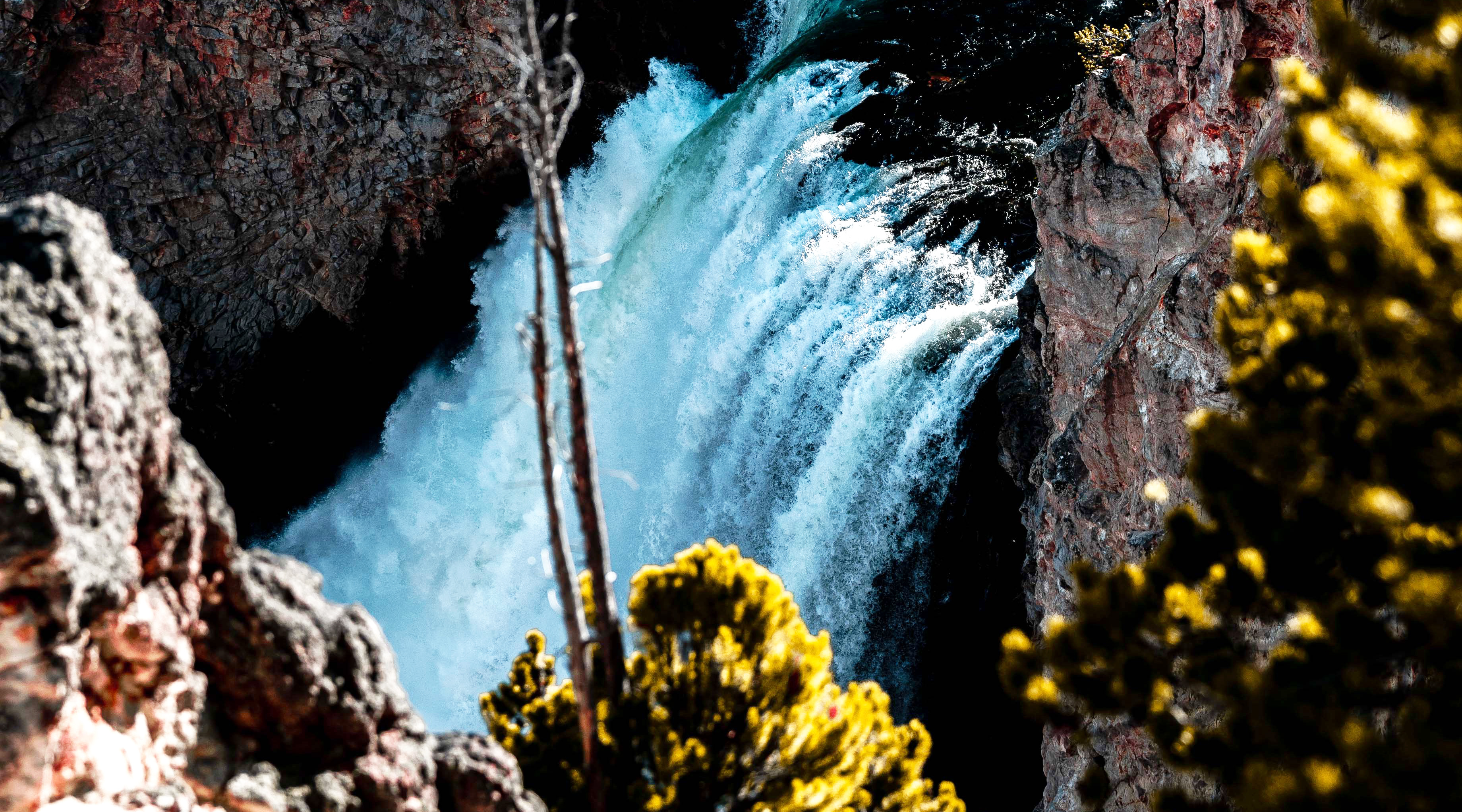
ISO200, 210mm, F7.1, 1/800sec

ISO320, 280mm, F6.3, 1/400sec
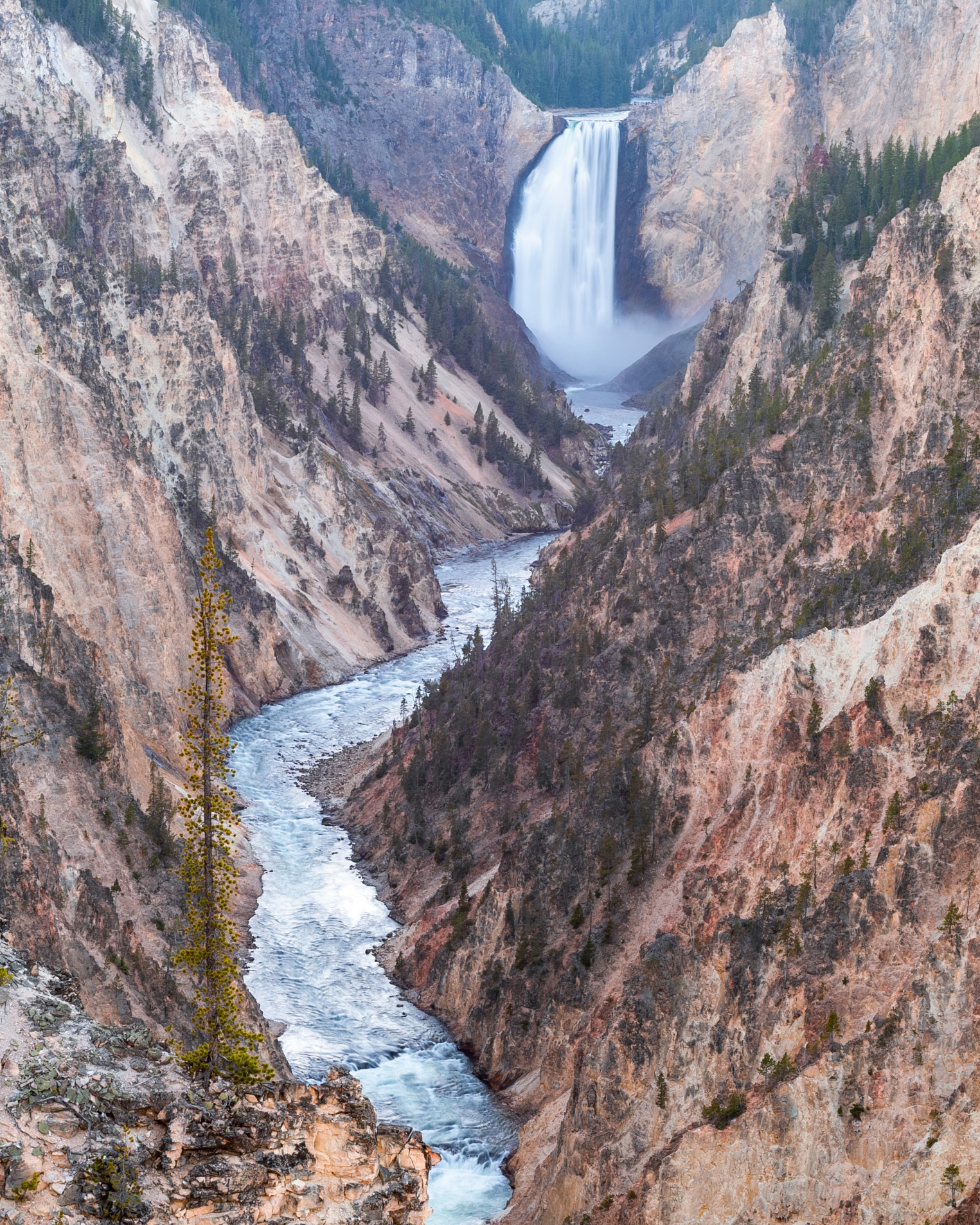
D810, ISO100, 50mm, F14, 0.8sec, Tripod

D810 ISO200, 500mm, F6.3, 0.5sec, Tripod

D810, ISO200, 500mm, F6.3, 1sec, tripod
THE SOUTH ENTRANCE
Photo tips: Stop at the parking spot right before the entrance, and head over to the edge of the pavement to witness the Snake River and the nearby hot springs. Bring along your Telephoto (200 mm), and the mid-angle lens for this scene to isolate the mist covered trees. Use a faster shutter speed to capture the steam as slower shutter may result in blurry picture due to fast movement of the steam. Enjoy the scene for a moment before heading inside the park.

ISO 100 200mm F8 1/250sec
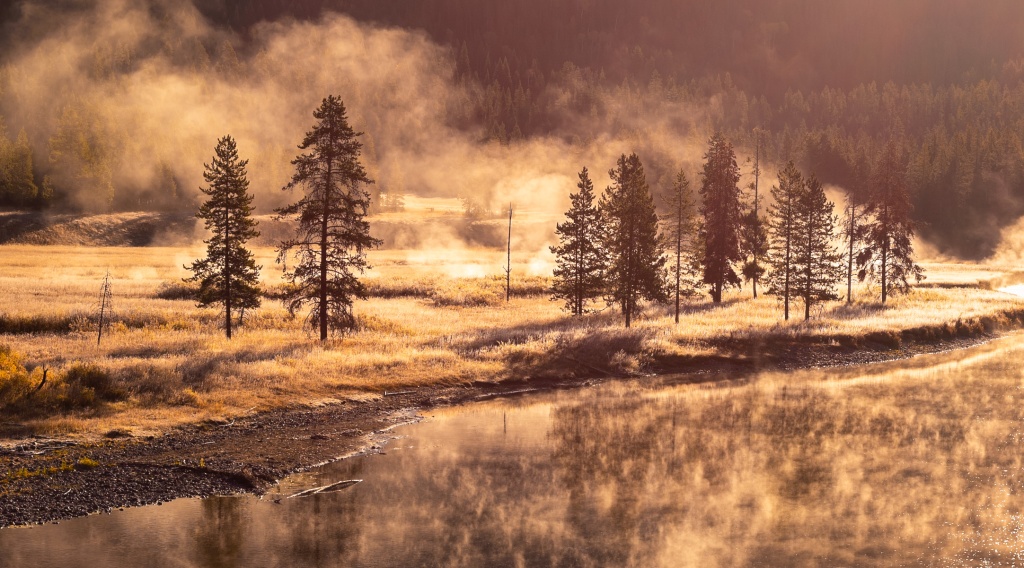
ISO100 50mm F8 1/320sec

ISO 100, 200mm, F8, 1/800sec
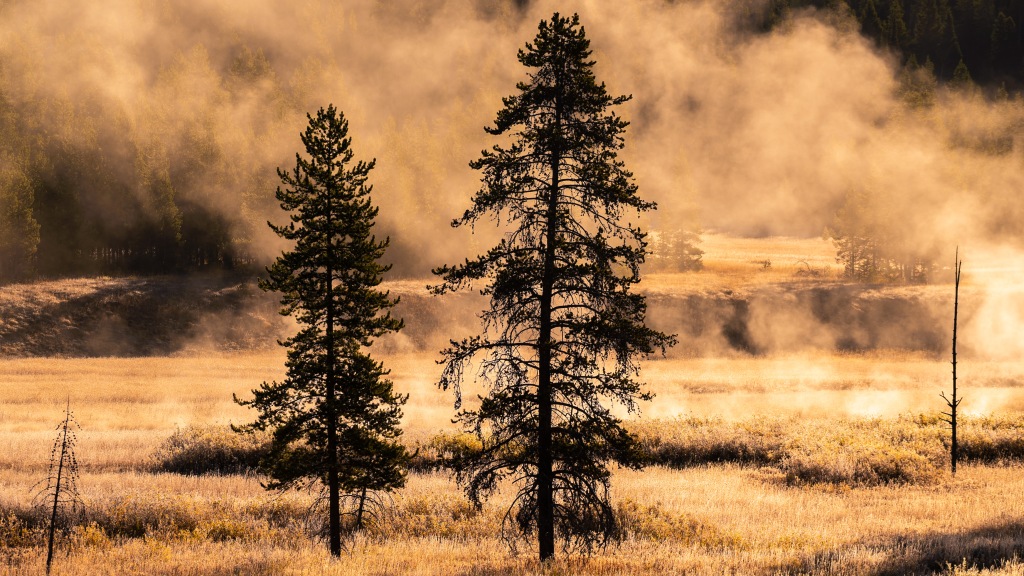
ISO100, 200mm, F8.0, 1/320sec
TURQUOISE HOT SPRINGS

ISO100, 16mm, F11, 1/320
Photo tips: The Best time to visit the pools is during the afternoon, when the pools are lit up with colorful Turquoise blue color and the surrounding areas are brightly lit with colors of bacteria. Do not forget to use your circular polarizer to cut down the reflections on the pool surface, and enrich the blue colors of the sky. Since these pools are large, a wide angle lens is a must to cover the whole pools and nearby mats.
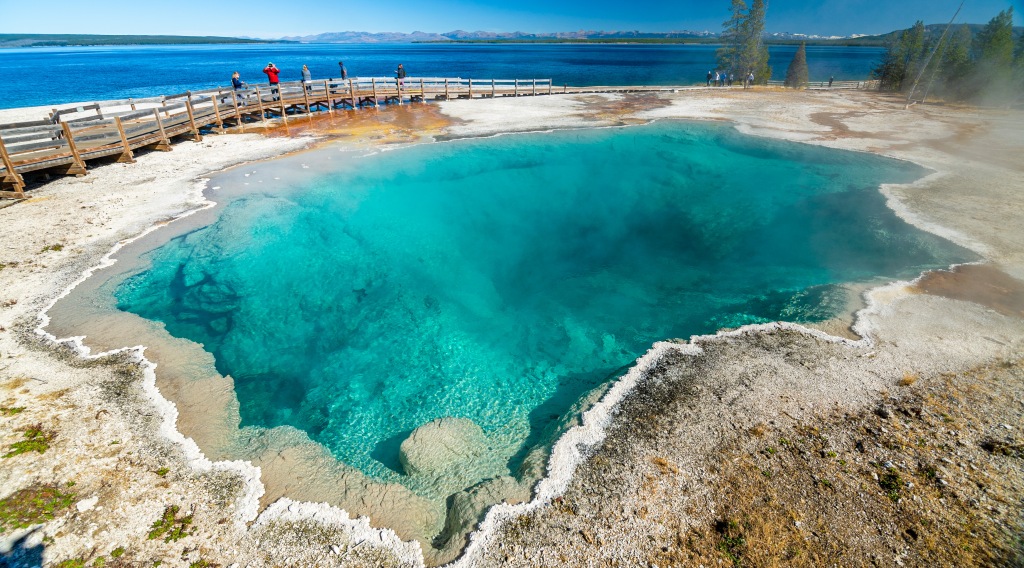
ISO125, 16mm, F11, 1/160sec

ISO125, 16mm, F11, 1/160sec

ISO 100, 16mm, F11, 1/500sec
ERUPTING GEYSERS

ISO125, 16mm, F11, 1/125sec
Photo tips: Plan ahead the timings of Geyser activity. This can be found in the link : https://www.nps.gov/yell/planyourvisit/geyser-activity.htm. Plan your trip based on this timing for geysers other than Old Faithful. If you see a large steam flow, you will be able to see it from a distance, hurry up to the location, and set up your tripod to immediately capture the scene with a wide angle lens. The steam goes really up in the air, so to cover the entire scene you will need an extreme wide angle lens (at least 16 mm). Enjoy the sounds of the eruptions.
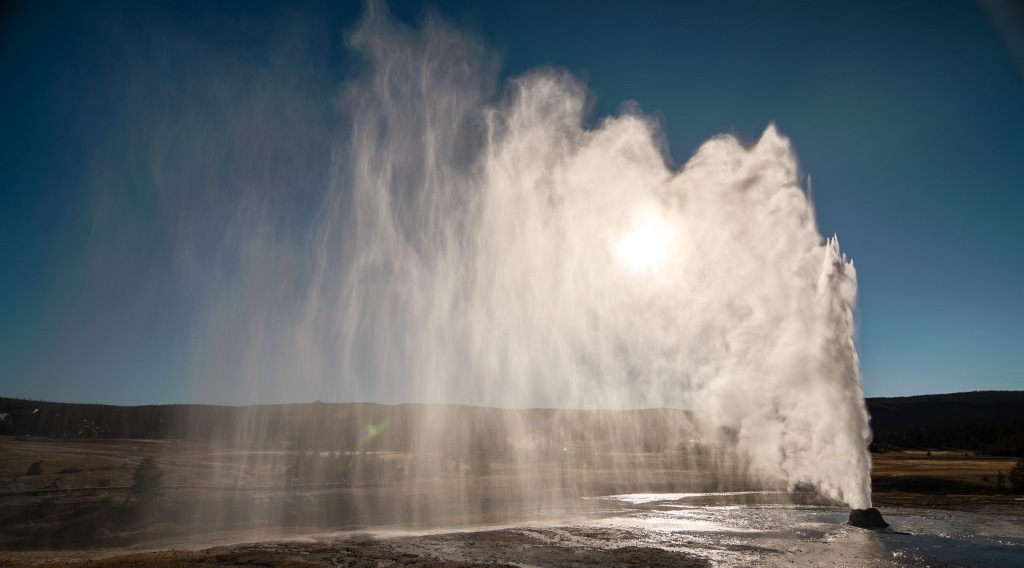
ISO 100, 16mm, F10, 1/1250sec

ISO 320, 16mm, F9, 1/1000sec

ISO 100, 16mm, F11, 1/125sec

ISO100, 16mm, F9, 1/500sec

ISO 320, 16mm, F2.8, 1/3 Sec
WILDLIFE AT LAMAR VALLEY & OTHER PLACES

ISO100, 200mm, F9, 1/320sec
Photo tips: To spot the wildlife you may need to bring in a binocular or the spotting scope. You will see many people with scopes with their family, and will often let you also see through their telescopes. Lamar Valley is a heaven to wildlife photography professionals. Bring along your telephoto zoom (500 mm and above) lens for capturing animals at the valley floor. If you are lucky, animals hangout near the road, wherein, a 200 mm-400 mm will suffice.

ISO100, 370mm, F9, 1/250sec

ISO100, 500mm, F7.1, 1/400sec
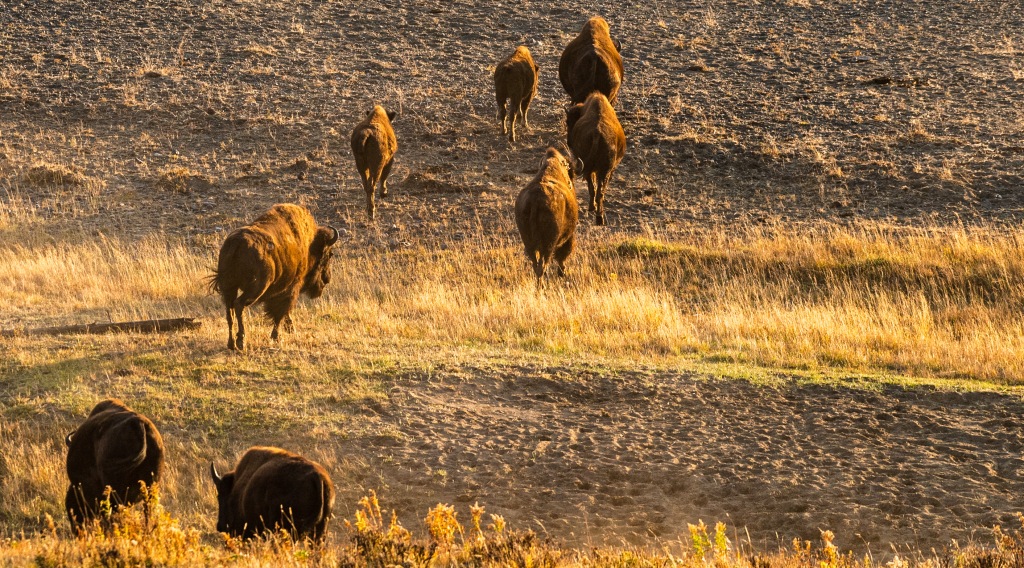
ISO500, 200mm, F6.3, 1/1000sec

ISO100, 500mm, F9, 1/200sec

ISO800, 230mm, F7.1, 1/1250
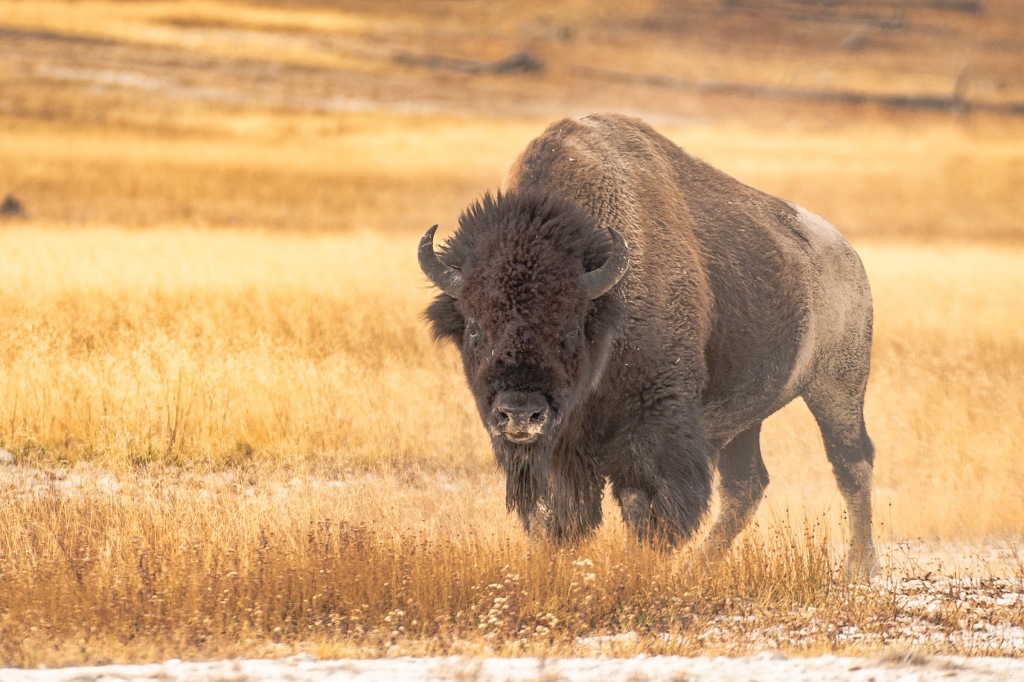
ISO500, 500mm, F7.1, 1/400sec

ISO800, 500mm F7.1, 1/8000sec

ISO800, 500 mm, F7.1, 1/320sec
Yellowstone’s natural beauty, grandeur, and wilderness has inspired photographers over many generations. The above list of photo spots will help you plan your photographic journey to Yellowstone, and help you identify interesting subjects and compositions on your own trip to the iconic park. There is a strong reason that this amazing park is protected as the first National Park of the world, as it holds stunning beauty that is yet to be discovered. With a keen eye, and sense of adventure, you will be presented with unique photo opportunities and wonderful memories that will last for lifetime.
Wow..wow.. What a great post! Superb photography!!
LikeLike
Lovely captures of the wildlife and natural landscape. This brings back such fond memories of when we visited Yellowstone a few years ago. It’s such a magical place.
LikeLike
Thank you for your thoughtful comment. Some how I found this comment in spam. I am happy I found it. I am glad it rekindled your memories.
LikeLiked by 2 people
You’ve given me good reason to pause and appreciate the unique color spectrum of each Yellowstone sight described above, I don’t need a camera to experience these moments for myself however.
LikeLike
Thank you 🙏 it’s indeed true.
LikeLike
Fabulous photos..will add Yellowstone to my list
LikeLiked by 1 person
Thank you.
LikeLike
Amazing photos!
LikeLiked by 1 person
Thank you 🙏
LikeLike
All the pictures are very beautiful.
LikeLiked by 1 person
Thank you.
LikeLiked by 1 person
Nice post. Just returned from Yellowstone and did some photography in the southern part of the park since the northern section was not open.
LikeLike
Glad to hear that. Flood has changed everything at Yellowstone. Thanks
LikeLike